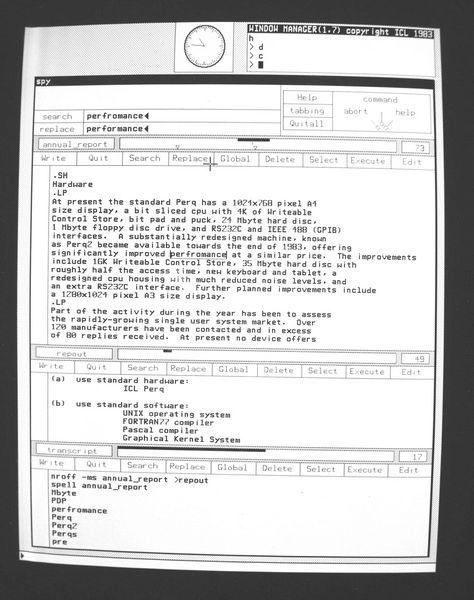

The Laboratory has been actively engaged in work supported by the Engineering Board. The year has been notable both for the success of the UNIVERSE Project and the announcement by the Government of the Alvey programme in Advanced Information Technology.
The Laboratory has played a major role in the planning of the Alvey initiative and will increasingly be involved in the research and coordination of the programme. SERC staff from the Laboratory are working alongside the Alvey Directors in all areas of Software Engineering, Very Large Scale Integration, Man-Machine Interface with Computers, Intelligent Knowledge Based Systems and Infrastructure and Networking.
Coordination of three of the Board's Specially-Promoted Programmes, Distributed Computing Systems, Industrial Robotics and Software Technology, has continued and the task of coordinating Council's activities in Image Processing and Pattern Analysis has been added to the Laboratory's responsibilities.
The Laboratory has been active in the field of radio propagation studies and this work has been drawn together into a Radio Propagation Research Unit. The propagation programme, in support of a number of government departments, has been actively pursued and the Laboratory has been strongly represented in national and international work on radio spectrum utilisation and propagation studies. The work of the Radio Communications Specially-Promoted Programme has been focused on the two areas of mobile communications and satellite communications and the Laboratory has been active with university groups in defining an Advanced Communications Engineering Research Satellite Project.
The Distributed Computing Systems (DCS) Programme has now been in existence for almost 6 years and is scheduled to terminate in September 1984. No new grants are being awarded under the Programme, but it continues to be actively coordinated and supported by the Laboratory. Increasing attention is being paid to transferring the results of the Programme to industry and the DCS Industrial Coordinator plays a key role in this. Technology transfer continues to be achieved by:
An important event during the year was the Industrial Conference held at the National Computing Centre in March and attended by some 120 senior technical managers. Proceedings of the Conference contain reviews of key technical areas which have emerged in the Programme (such as local area networks, non-von Neumann architectures and declarative languages) and reports from individual projects, eg the Manchester Dataflow Project. In June, a technical conference was held at the University of Sussex at which some 20 research groups presented results. The technical workshop programme continues to be a key means of fostering links between research groups. During the year, meetings were held on topics ranging from high-speed computer architectures to declarative languages.
DCS support staff have been mainly involved in Common Base developments (see Section 5). The development of software to link systems running the UNIX operating system X25 networks continues at the University of York under an Extra-Mural Research Agreement with the Laboratory. The software is now in use at a number of sites; support staff were heavily involved in the commissioning phase of this project.
Detailed descriptions and progress reports on each of the projects in the Programme are contained in the DCS Annual Report. A Conference to mark the termination of the Programme is being planned for September 1984.
A SERC Panel recommended that SERC should mount major new initiatives in several fields of Information Engineering, one being Software Technology. As a result, SERC's Computing and Communications Sub-Committee (CCSC) launched the Software Technology Initiative (STI) in 1982, which will run for approximately 5 years. The CCSC has identified three major objectives for STI, viz to:
The Laboratory is coordinating and supporting STI. A coordinator is responsible for implementing policy, stimulating new grant applications, coordinating existing work and encouraging technology transfer. The RAL support work involves the operation of the Common Base Policy (see Section 5) by orientating software technology development towards PASCAL, FORTRAN, the GKS graphics standard, UNIX operating system, PERQ single user computers, Cambridge Ring local area networks and X25 wide area networks.
Under STI, steps have been taken to:
Current plans include the setting up of software technology centres, coordination and collaboration between funding bodies, an increased level of research activity and the creation of software engineering development and user communities. The British academic community will then be drawn into closer association with British industry to effect the two-way transfer of software technology which is so vital to a modern industrial society.
STI has set up a Software Technology Centre at York University specialising in ADA, a Software Tools Centre at UMIST specialising in PASCAL and a Software Tools Centre at Kent University for FORTRAN, quality control, tool collection and distribution. A large number of workshops has also been held on topics ranging from theorem-proving to ADA compilation. These workshops have been well supported by industry. STI now has over 35 active research projects in 20 universities.
During 1982 a committee under Mr J Alvey recommended to UK Government that a major new initiative in Information Technology should be launched. RAL staff helped to prepare the Alvey Report; the STI Coordinator was seconded to help prepare the Software Engineering section. The Alvey programme began in June 1983. The SERC-sponsored STI will be merged with the Alvey Software Engineering Programme; the STI Coordinator has become a member of the Alvey Directorate staff.
With the growth of software engineering research management and RAL intramural activity, a new Software Engineering Group was set up on 1st August 1983.
The UNIVERSE Project has now been in progress since April 1981 as a research project in advanced computer networking between seven partners, viz Cambridge University, Loughborough University of Technology, University College London, GEC Research Laboratories (Marconi Research Centre), Logica UK Ltd, Rutherford Appleton Laboratory and British Telecom Research Laboratory. During 1982, a high bandwidth network was constructed. This network uses Cambridge rings for local communication at each of the sites, and the sites are linked together for wide-area communication by a broadcast satellite channel on the ESA Orbital Test Satellite (OTS). The network, which supports peak transmission rates approaching 1 Mbit/sec, has been in operation during the year both for applications experiments and for network performance measurement. Fig 2.2 shows how the network might be used for office communications.
Apart from some reliability problems with the satellite earth-stations, the network has performed well and has proved very easy to use. Sixteen experiments have been carried out on the network during the year and RAL has played a major part in six of them. Extensive measurements have been carried out on the satellite part of the network both in normal use and for broadcast transmission in which a single client computer is sending the same data to many receiving computers. Protocols for carrying digitised voice on the network have been developed and these have been used for both normal conversations and for building a stored-voice messaging system. A similar system for handling video images has also been developed. The network is fast enough to allow the use of applications which require full-screen terminal handling. A system which allows normal terminals to emulate the IBM 3270 full-screen terminal and access VM/CMS across the network has been demonstrated successfully. Finally, a major system for handling the distribution of files across the network is being developed. In this system, computers called agents handle the particular local requirements of their client systems and then employ special fast protocols to ship files across the network to other agents using broadcast methods if necessary. By this means, user systems are relieved of the problems of handling reliable and efficient file transfer across the network.
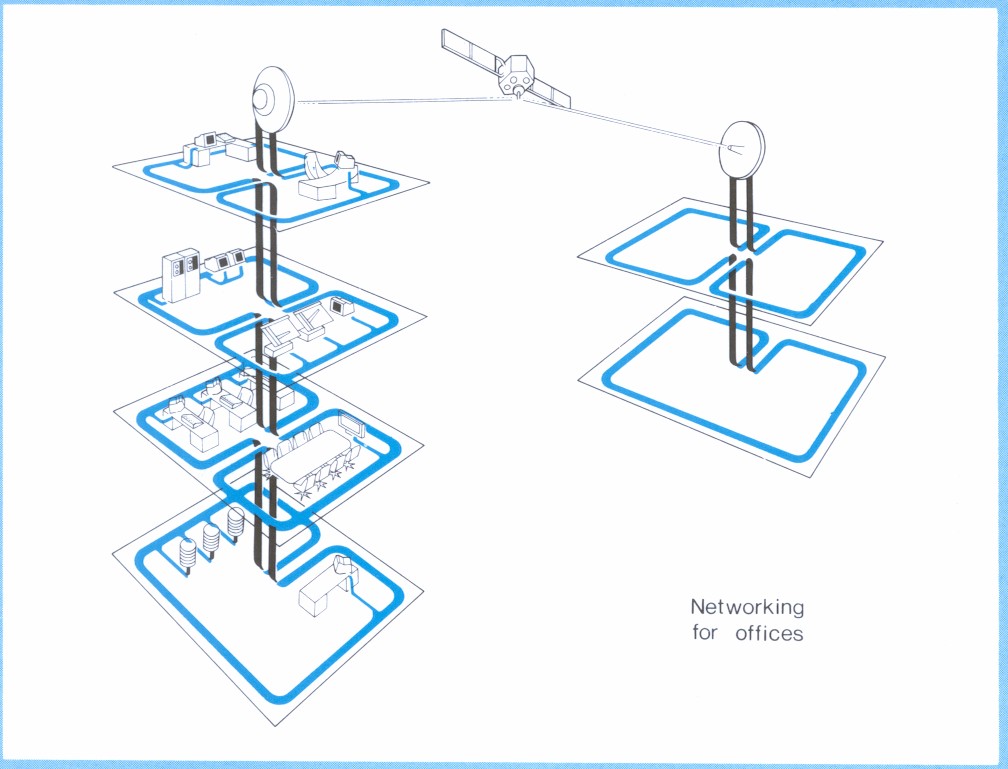
In addition to the research activities, the project has mounted three public demonstrations of the UNIVERSE network during the year. Two of these, INFO '83 and Business Telecoms, were held at the Barbican centre in London and the third, World Telecom '83, was held in Geneva. At the INFO '83 exhibition in February, the UNIVERSE network was formally opened by Mr William Shelton MP, Parliamentary Under Secretary at the Department of Education and Science. Each demonstration involved setting up a complete UNIVERSE site including a large ring with more than fifteen computers attached, together with a satellite bridge and mobile earth-station to connect to the other sites. To reach the earth-station site, the ring at the Barbican had to join two locations about one kilometre apart, giving a ring some two kilometres in length. Transmission over the long sections of this ring used fibre optic cables. In Geneva, the site was again divided between some demonstrations in the main hall and further demonstrations in a container which was situated in an open exhibition area together with the mobile earthstation. A full range of application demonstrations was shown at each exhibition including packet voice and packet video, as well as fast text, graphics and image retrieval. Geneva visitors were able to control a' robot arm at Loughborough, viewing the position of the arm on slowscan colour TV.
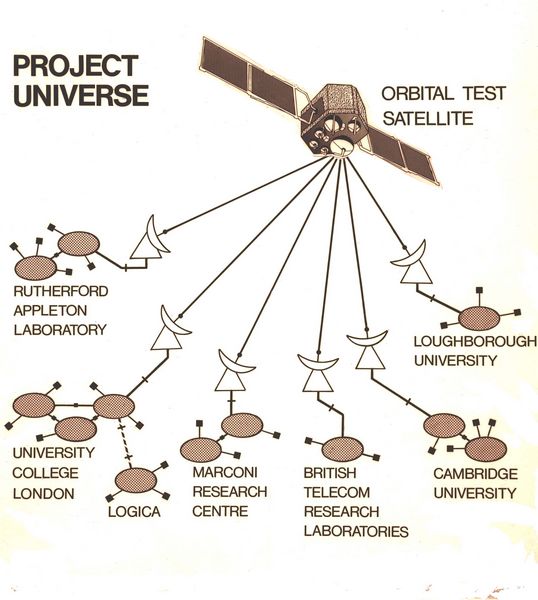
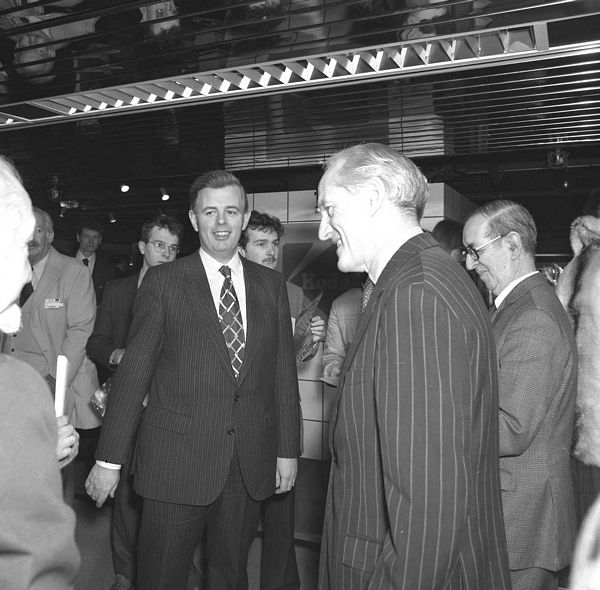
The level of interest shown in many aspects of the project by potential customers at the exhibitions indicated that there are many market opportunities to be exploited by the industrial partners.
RAL provides support and development for computing methods over a wide range of engineering applications. The main areas covered are:
Throughout this work, the common theme is mathematical modelling strongly supported by a software infrastructure. The problem to be solved must be described to the computer and the subsequent graphical presentation of the results carried out. In these areas, the Laboratory is advised by Special Interest Groups which identify the requirements of the research community.
One of the most important aspects of any applications software package is the user interface. Supplying a good interface requires a large amount of software that is independent of the particular application. In order to encourage researchers to produce usable applications software packages, a range of tools is provided, including:
The software packages DECODE, GILT and BOXER were introduced during the year and new versions of FEMGEN, FEMVIEW and RUTHLESS were mounted. This software is available on the multi-user minicomputers of the Council's interactive computing facility. The software tools needed for single user systems are being investigated.
The finite element technique is used as a tool for engineering design calculations and is also an active research topic. Standard commercial finite element packages provide all that is required for a wide range of engineering design calculations including stress analysis and heat flow. The most powerful commercial package for these calculations is NASTRAN: this is supported for use in Laboratory projects and by academic engineers. Research opportunities are plentiful as many calculations cannot be performed by commercial systems, in particular in fluid dynamics. To satisfy these needs, a library of finite element software is provided by the Laboratory and distributed by Numerical Algorithms Group Ltd (Oxford). The library enables researchers to create efficiently new finite element software packages that are well structured and this in turn has led to a fruitful exchange of software between different groups. Currently, the library is being used for semiconductor modelling, building design, machine tool design and fluid flow calculations. These developments have produced new software which has been included in the library.
The Laboratory's electromagnetic software packages provide facilities which cannot be matched by any other software suite. The packages are heavily used by Engineering Board grant holders and also in projects funded by the Science and Nuclear Physics Boards. The software handles two and three dimensional static non-linear electromagnetic field computation and time-harmonic or transient fields in two dimensions. A project to develop a time-harmonic eddy current program in three dimensions is nearly complete and the package should be available by early 1984. The packages are available commercially from the British Technology Group; PRIME CAD/CAM Ltd are the licensed agents. There is an active academic and industrial community of users of the electromagnetic programs working on a variety of projects ranging from cathodic protection to detector magnets for particle physics research. During the year, the computed designs of the magnets for the Spallation Neutron Source (see Section 4) have been compared with experimental measurements. As an example, the computer model of the EVB2 magnet yoke is shown in Fig 2.3 where experimental results in good agreement with computer predictions are also presented. Four user courses on the electromagnetic software packages were held at the Laboratory during the year.
The Laboratory is the prime contractor in a collaborative project which is 50% funded by the EEC initiative in microelectronic technology. The aim of the project is to develop better methods for modelling the behaviour of semiconductors. The other partners are GEC at its Hirst Research Centre, Nederlandse Philips Bedrijven BV at Eindhoven, University College Swansea and Trinity College Dublin.
Micron and sub-micron semiconductor devices exhibit behaviour that can be related to the three-dimensional nature of the devices. Larger devices can be modelled accurately in two dimensions and numerical methods are available for such calculations. These methods are extremely expensive for calculations in three dimensions. The project started in April and the first phase has included a detailed comparison of existing methods in two dimensions. The partners have implemented different algorithms and the strengths of the various approaches have been analysed. Special finite element packages have been created in order to improve the modelling of the rapidly varying potentials and charge densities within the devices. The finite element library is being used as the basis for this work.
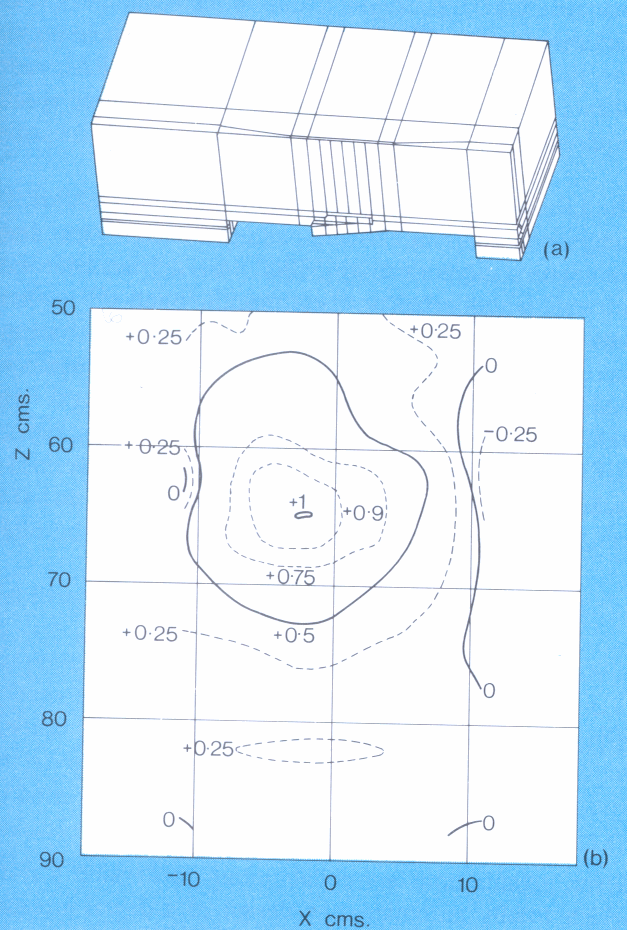
The network of GEC 4000 machines has continued to expand, with a new GEC 4090 Multi User Mini (MUM) at Leicester, six GEC 4000 workstations replacing GEC 2050s, and GEC 4190 and 4160 MAIL machines installed at RAL and SERC Central Office, respectively. This brings the total number of machines directly supported by Computing Division to 30. In addition, the RAL software is used at a number of other non-SERC sites.
The use of the GEC 4000 for special functions, as exemplified by the two MAIL machines, has continued to grow. Enhancements to the GEC MAIL facilities have enabled a Computing Division mail service to be set up, which allows all members of Computing Division to communicate with each other using electronic mail. Non-computer users have their mail printed automatically and delivered through the internal mail system. Communications with outside organisations have been improved by the ability to send and receive electronic mail from Telex and British Telecom Packet Switched Service (PSS) subscribers.
Amongst a large number of improvements to the software was a major overhaul of the spooling system. This work provided improved output routeing facilities and much better operator control over spool queues. Facilities were also included to drive remote printers over an X25 network using terminal protocols. This enables the GEC to act as a print server, receiving output files from anywhere on the network and routeing them to printers connected to packet assemblers/disassemblers (terminal concentrators) on the network.
The GEC 4000s have become the first network of machines to support the Job Transfer and Manipulation Protocol. This is a complex protocol for the submission, transfer and control of jobs through a network. The software was developed by Computing Division.
Considerable effort has been put into documentation, and a completely revised Reference Manual 2 has now been published. This consists of a detailed description of about 150 commands which are recognised by the operating system. Work is now under way on Reference Manual 1.
Other areas which require considerable effort are those of maintenance, support, and the delivery of new systems. About 10 queries and fault reports are received every day by support staff via an on-line Support File. Most of these come from remote Site Managers, who themselves filter many of the queries from their local users. All entries in the Support File are eventually dealt with, though some may take a considerable time when obscure faults are reported, or new facilities requested.
During the past year the PRIME 400 at the University of East Anglia was upgraded to PRIME 550 Mark II with the University contributing a significant part of the cost. Memory upgrades have taken place at most sites to cope with the extra load imposed by the more sophisticated Revision 19 of PRIME software. Disk capacity has also increased on some RAL PRIMEs. The installation of Revision 19 was a major event. The change affected all users because of significant enhancements to the file system. The Revision 19 SERC PRIME Reference Manual, produced by UMIST has been distributed and work on the Primer and Applications Guide is well under way.
The PRIME EMACS screen editor has been purchased together with memory upgrades to support screen editing without a degradation in response. A LISP/PROLOG compiler from Salford University has been ordered. The Salford FORTRAN 77 compiler is widely used on the SERC PRIMEs as an alternative to the PRIME compiler.
Support of the Job Transfer and Manipulation Protocol is planned, and there is a commitment to keep up to date with wide area and local area network developments. There is also a great deal of interest in the announcement by PRIME of a commitment to provide Bell System III UNIX to coexist with PRIMOS, the PRIME operating system.
Support has continued with registration of SERC users and monitoring of machine usage. There have been exercises to improve performance by better distribution of disk space. An excess of resource has meant that it has not been necessary to move work between machines. Work has continued on presenting statistics at Board and Committee level to allow assessment of the use and hence cost effectiveness of these machines.
The UNIX operating system has been popular with the Computer Science community for many years. This popularity is rapidly spreading to others, as versions of it are becoming available on many micros. At RAL, UNIX has been used to underpin the coordination work of the Distributed Computing Systems (DCS) Programme (see Section 2) and will be used with the new Software Technology Initiative (STI) (ibid). With the probability of involvement in the Alvey Information Technology Programme (ibid) growing, it was decided to bring the management of the various machines together, to provide better support for the particular communities.
UNIX (Version 7) is run on a PDP 11/70 for DCS users, and UNIX (Berkeley 4.la) has been mounted on a VAX 11/750 for those involved with the STI coordination. Most of the effort this year has been directed into organising the code for the different versions of UNIX, to allow system development to take place without affecting the main versions. Much use has been made of the Source Code Control System which allows multiple versions to be managed effectively. Depending on the requirements of the users, it is probable that more versions may be required (eg Berkeley 4.2, Bell System V, etc).
High quality graphics are available on single user systems having a bit mapped display, a powerful CPU, high interaction rate, significant local disc storage, and low cost. This combination of features, together with the UNIX multiprocess operating system and a powerful Window Manager means that today's scientific and engineering users can work in a much more productive way than before. Since these systems are (relatively) cheap, many different types are on the market. In the absence of any policy, much valuable research effort would be expended in duplicating tools required for the various machines. In addition, the ability to move software easily from one research group to another, or from research to industry ('technology transfer') would be greatly reduced. Council has decided to try to prevent this situation developing by defining a Common Base Policy which requires the use of:
This provides a standard working environment for the vast majority of users. (For specific applications, hardware or software not in the Common Base might be appropriate.) In time, an increasing range of software will become available to Common Base users; new hardware will also arrive, providing always that it is capable of supporting Common Base software and communications.
Overall, the Common Base can be seen as providing improved communications in the widest sense between:
At present the standard PERQ has a 1021×768 pixel A4 size display, a bit sliced cpu with 1K of Writeable Control Store, bit pad and puck, 24 Mbyte hard disc, 1 Mbyte floppy disc drive. and RS232C and IEEE 488 (GPIB) interfaces. A substantially redesigned machine. known as PERQ2 became available towards the end of 1983, offering significantly improved performance at a similar price. The improvements include 16K Writeable Control Store, 35 Mbyte hard disc with roughly half the access time, new keyboard and tablet. a redesigned cpu housing with much reduced noise levels, and an extra RSZ232C interface. Further planned improvements include a 1280×1024 pixel A3 size display.
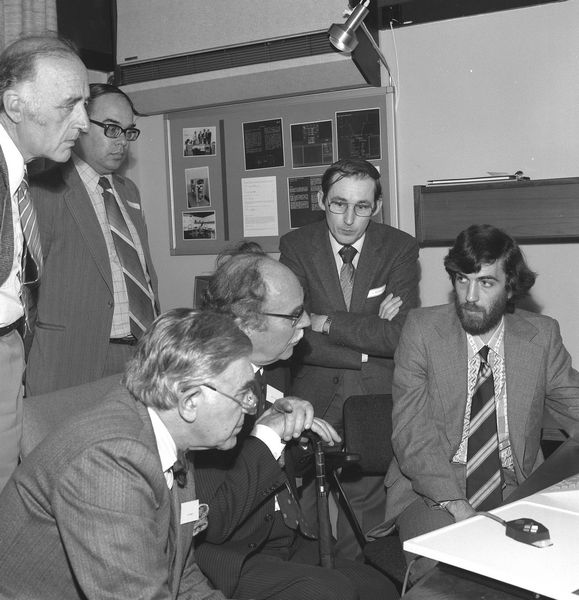
Part of the activity during the year has been to assess the rapidly-growing single user system market. Over 120 manufacturers have been contacted and more than 80 replies received. At present no device offers the exciting graphics performance of PERQ, but it is clear that in about 12 months from now a few suppliers will be able to offer graphics similar to the current PERQ2 and having better CPU power and other features; it is therefore likely that another machine will enter the Common Base in the near future.
The first version of UNIX for the PERQ (PNX) became available from ICL in February. This offered the C compiler only, together with an early version of the Window Manager which permits easy access to the PERQ screen and rapid manipulation of the information displayed there. The next release of PNX, version 1.5, made a FORTRAN77 compiler available as well as an improved window management system. The following month saw the issue of a pre-release of the PASCAL compiler. A pre- release version of the GKS graphics package took place in December with a general release scheduled for 1984. Release 2.0 of PNX, expected soon, will provide improved compilation speeds generally, much improved single precision FORTRAN floating point performance, a source level debugger, a screen editor (see Fig 5.6 which shows the screen in use to edit the above paragraph), a Window Manager with increased speed and better functionality, and utilities from the UNIX System III Programmer's Workbench, as well as microprogramming tools and font and cursor editors.
A number of contracts have been let to provide software for the Common Base. The NAG Library, LISP, PROLOG, ADA, PASCAL PLUS and parts of the TOOLPACK system have all been funded, one by the Computer Board and some others as part of the Engineering Board's Software Technology Initiative. In addition, a FORTRAN Tools Centre has been established.
Asynchronous communications, allowing terminal emulation and transfer of small files, can be done using the chatter and puftp utilities, with more robust file transfer being possible with the asynchronous file transfer protocol originally defined for the Interactive Computing Facility multi-user minicomputers. A contract with the University of York for the development of JNT Coloured Book X25 connection for PERQ yielded a working prototype under PNX 1.5 in August. This permits file transfer, mail and remote login across the academic network. PNX 2.0 is scheduled for general release.
Where local area networks are concerned, Cambridge Ring developments have been much slower than planned. At present, only the Basic Block Protocol development is scheduled for PERQ, with completion scheduled for 1984. The requirement for a fast local area network with attendant services has meant that investigation of the use of Ethernet for Common Base communications is now planned.
A Common Base Support Office has been set up and staff acquired and trained. At present the main medium for communication with users is the telephone, but as communications facilities improve a network-based service will be adopted. Some limited use of a PDP 11/70 UNIX system in RAL has already been made for this purpose.
Two User Meetings were held in February and September with over 50 users attending each meeting. As well as presentations from ICL and SERC staff describing developments, a number of user presentations were also given with much useful information being transferred.
Cooperation between RAL and Queen Mary College, which acts as the lead site for the Computer Board-purchased PERQs, has been extended over the year and there are plans to improve further the level of service by unifying documentation and training as far as possible.
